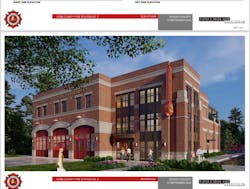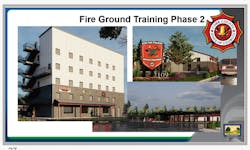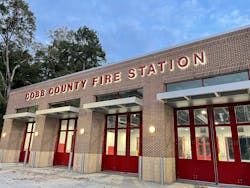Fire stations are unique buildings that do not fall under a single building classification. These structures must accommodate not only sleeping quarters and automotive storage, but also allow for maintenance, office space, storage, and meal preparation. The design of fire stations must also contemplate decontamination/cancer prevention, training, and often, onsite fueling. These diverse building applications can create challenges in the design and construction of the stations. Picking the correct construction delivery method or bid process can optimize the outcome while limiting risk, helping to control both build cost and ongoing costs, and limiting the challenges related to the design and constructability of the next station.
Processes within administrative and purchasing departments can greatly affect the cost and the quality of the project. Selecting the proper procurement method will influence the pace of the project, the owners experience during and after construction, the interest of contractors, and the performance of the building for years to come. The most common construction delivery methods are Design-Bid-Build, Construction Manager at Risk (CMaR), and Design-Build. Selecting the type of delivery for the Request for Proposal or Qualifications (RFP/RFQ) in the advertisement will set the tone for the entire project.
Hard/low bid
Municipalities and county officials are most familiar with the traditional Design-Bid-Build approach, which may be referred to as low bid. When using this method for new construction, the jurisdiction starts by hiring an architect to create a full set of construction documents. The goal of this approach is to determine and select the bidder for the lowest cost for the project. When creating an Invitation to Bid (ITB) it is critical to establish absolute minimum standards for prospective bidders to ensure the lowest bid is from a qualified vendor. When using a bid process for your fire station you will start with selecting an architecture firm to lead in the creation of the Construction Documents (CDs) used for the ITB. This selection can also be made using the bid process, but for the sake of this article, we will focus on the construction portion of the process.
During the creation of the CDs (drawings and specifications), these can be included in the ITB or an RFP. When the bids are received and opened in the Design-Bid-Build approach, typically the low bidder is awarded the project. On the surface, this may seem like an effective way to select your builder and have your capital construction funding maximized, but there can be some major drawbacks that we will highlight.
The process may ultimately result in the selection of an unqualified general contractor (GC), or one that uses subcontractors who may not be experienced in the construction methods required for a fire station. Another concern is change orders due to errors or details not included in the CDs. Any item left out of the drawings or specifications may result in change orders, often at a much higher cost than if the scope of work had been captured upfront. This can also create animosity between the owner, architect and GC, resulting in a strained relationship that can last throughout the construction phase and beyond. The most impactful consideration in a construction advertisement is attracting the most qualified contractors. Cities and counties have evolved their processes to select more qualified teams to complete their construction projects through the CMaR and Design-Build approaches.
Construction Manager at Risk
The CMaR approach provides the administrators with a qualified design and construction resource that understands the unique requirements of their fire services project. The RFP or RFQ can mix the qualification processes with a price proposal, which may be referred to as a guaranteed maximum price or GMP. This approach provides key stakeholders in the process, fire command staff, input in selecting the most qualified experienced designer and construction manager (CM)/GC in two separate selection processes. Scoring or evaluations of the proposals should be agreed upon as the advertisement is created.
Unlike the hard bid, the selection process for the CMaR method allows you to score in areas such as: experience, staffing, approach, availability, and price. Change orders can again be an issue with this approach unless your CM has been involved in the development of the CDs with your architect. It is critical in this model to select the contractor early enough to be a part of the programming to review the constructability of the design as documents are being developed. Change orders are not always the fault of the architect or bad design but can arise when the field work runs into unforeseeable issues.
Design-Build
Another option for construction delivery is the Design-Build method, where you select a team that will together design and build your fire station. This advertisement process may begin by creating bridging documents or detailed requirements for the RFQ instead of complete construction documents and specifications. Bridging documents may illustrate the concept of the design, along with services, and other requirements for the quality of the build. These requirements will allow a Design-Build team that includes the architect, engineers and the GC, to submit their qualifications that match your project. A big advantage to this method is the collaboration between the architect and the contractor. This minimizes the change orders and allows the owner, architect and contractor to develop the best design and constructability during the design phase.
The collaboration of this teamwork may produce a more well-thought-out design and a better product. A strong/experienced design build team will find the inefficiencies of the design, reduce the chances of change orders and promote value engineering during the design phase. This too can be achieved in a CMaR if the contractor is onboarded early in the design. A distinct difference with design build is the advertisement portion. By using a simpler design in your bridging documents, you will not have the large cost up front from the architect and that gives you flexibility to change or modify your design once the team is selected. A strong/experienced design team will identify challenges with the site, design, and constructability prior to GMP.
Whichever method you choose it is important to understand how the method affects the bid or proposal. There is an assumption that a hard bid saves money but ultimately this delivery method can cost more when changes are made, or a subpar contractor is selected. There may be times when utilizing the hard bid method is the best approach, such as for smaller projects, where the risk of costly changes is reduced. Examples might include kitchen and bathroom renovations.
The CM at risk method can also have a high risk of change orders if the contractor is not involved early in the design, but the selection process for a contractor provides a scoring system to better select a qualified contractor. CMaR is a more preferred method when you are reusing a station design or have a high level of confidence in your design team, and you wish to maintain control over their selection.
The Design-Build method is recommended for any new design or situation where you prefer to maintain control over contractor selection as well as have a single point of contact throughout the entire process. It has been our experience that the Design/Build delivery method typically results in much smoother project from start to finish, and ultimately a better product. It allows for a more custom design with value engineering from start to finish.
About the Author

Adam Storey
Adam Storey is a division chief with Cobb County, GA, Fire and Emergency Services, where he has served since 1997. He also is the executive officer for the director of public safety. As the chief of logistics, Storey is responsible for capital improvements, facility maintenance, apparatus maintenance and support services. he holds a bachelor’s degree in human resource management and an associate degree in business administration and is a graduate of the University of Georgia’s Carl Vinson Institute of Government’s Management Development Program.



